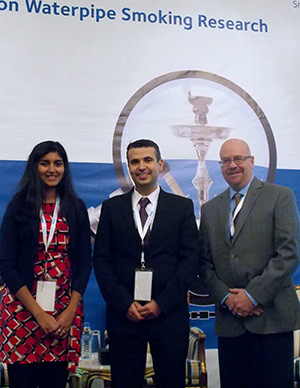Hookah smoking: popular among college students, may be more harmful than cigarettes
December 4, 2014

Left to right: Farahnaz Islam, Ramzi Salloum and Frederick Kates present at the Second International Conference on Waterpipe (hookah) Smoking Research in Doha, Qatar.
Ramzi Salloum, assistant professor of health services policy and management (HSPM), and his research team have determined that waterpipe (commonly known as hookah) smoking has steadily increased over the past decade to become a public health threat. Waterpipe smoking, most common among adolescents and young adults, may be just as toxic as cigarette smoke if not more so. Despite common misconceptions that waterpipes are less harmful than cigarettes, waterpipe smokers are exposed to higher levels of smoke, carbon monoxide and carcinogens such as polycyclic aromatic hydrocarbons, than cigarette smokers. This additional exposure is due to the method used to heat the tobacco, through burning charcoal.
“Over the past decade, evidence has been building on the harmful effects of waterpipe smoking,” said Salloum. “Waterpipe tobacco use may be associated with adverse health outcomes, including cardiopulmonary diseases, cancer, mental health issues, addiction and carbon monoxide poisoning.”
The study, published in Tobacco Control, found that the popularity of waterpipe smoking has increased in the U.S. over the past decade, particularly among college students. Approximately one third of college students have tried waterpipe smoking, and 10 percent are current smokers. The researchers have further unpublished evidence based on GIS analysis that waterpipe smoking establishments are popping up near colleges and universities throughout the U.S., where waterpipe smoking prevalence exceeds 30 percent.
To protect public health, Salloum says that clinicians and health care providers should be aware of the increasing prevalence of waterpipe tobacco use and associated health risks. A diagnosis of carbon monoxide poisoning should be considered in situations with unexplained confusion or change in mental status, particularly in young adults with no other obvious risk factors.
To help share this message, Salloum and two students from his research team, HSPM doctoral student Frederick Kates and biostatistics master’s student Farahnaz Islam, presented their findings in Doha, Qatar at the Second International Conference on Waterpipe (hookah) Smoking Research: A Collision of Two Epidemics of Waterpipe Cigarettes in October. Over 100 health experts from around the world convened at this conference to expand the understanding of how the waterpipe epidemic is connected to cigarette smoking and the implications of such interaction for policy and intervention.
Salloum and his research team are dedicated to identifying effective policy intervention tools to increase awareness and control the threat of this emerging epidemic, particularly in the U.S. Their future research focuses on developing and evaluating effective regulatory tools that will inform policy makers in addressing this public health issue.



_01.jpg)
_02.jpg)